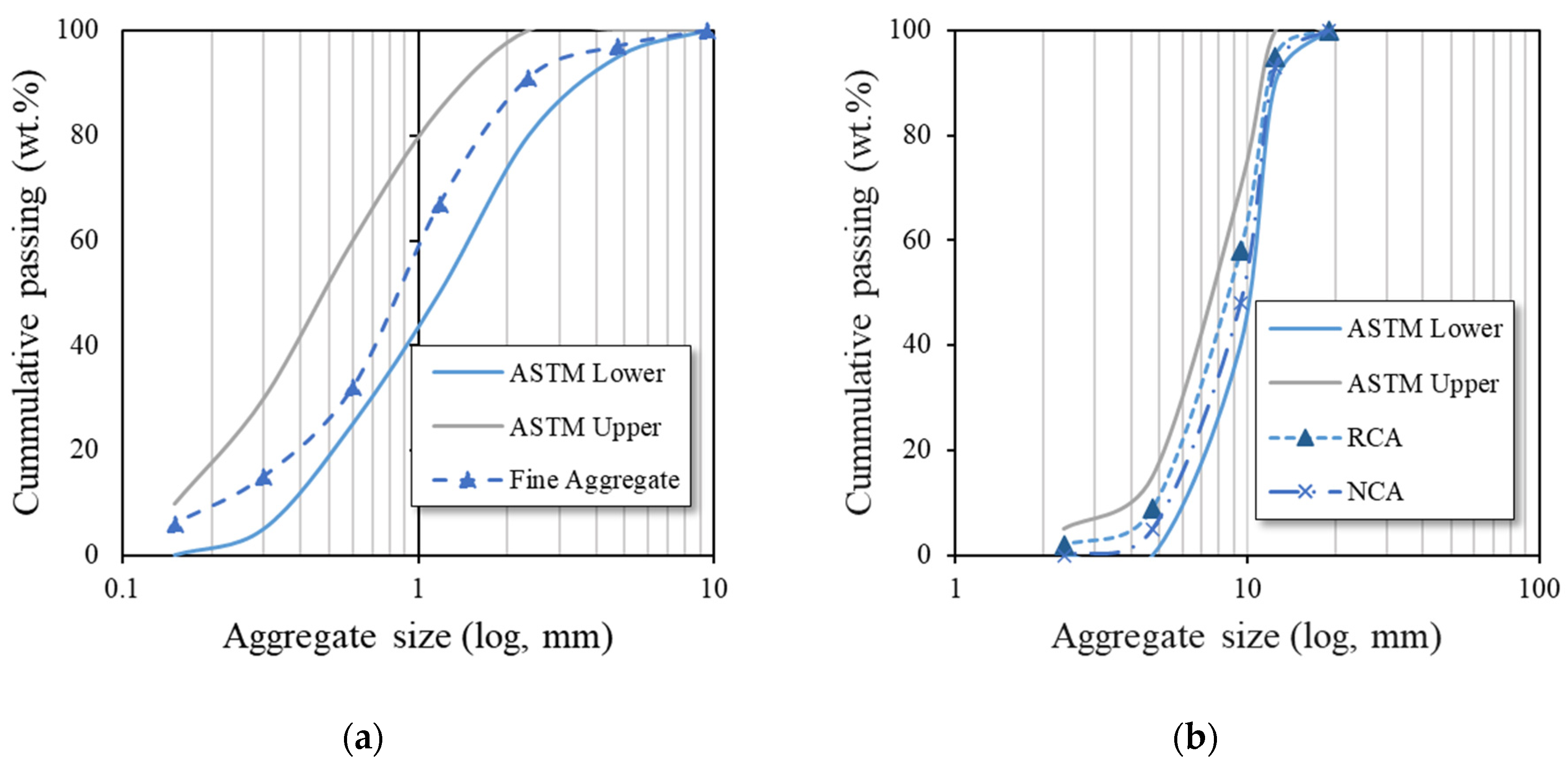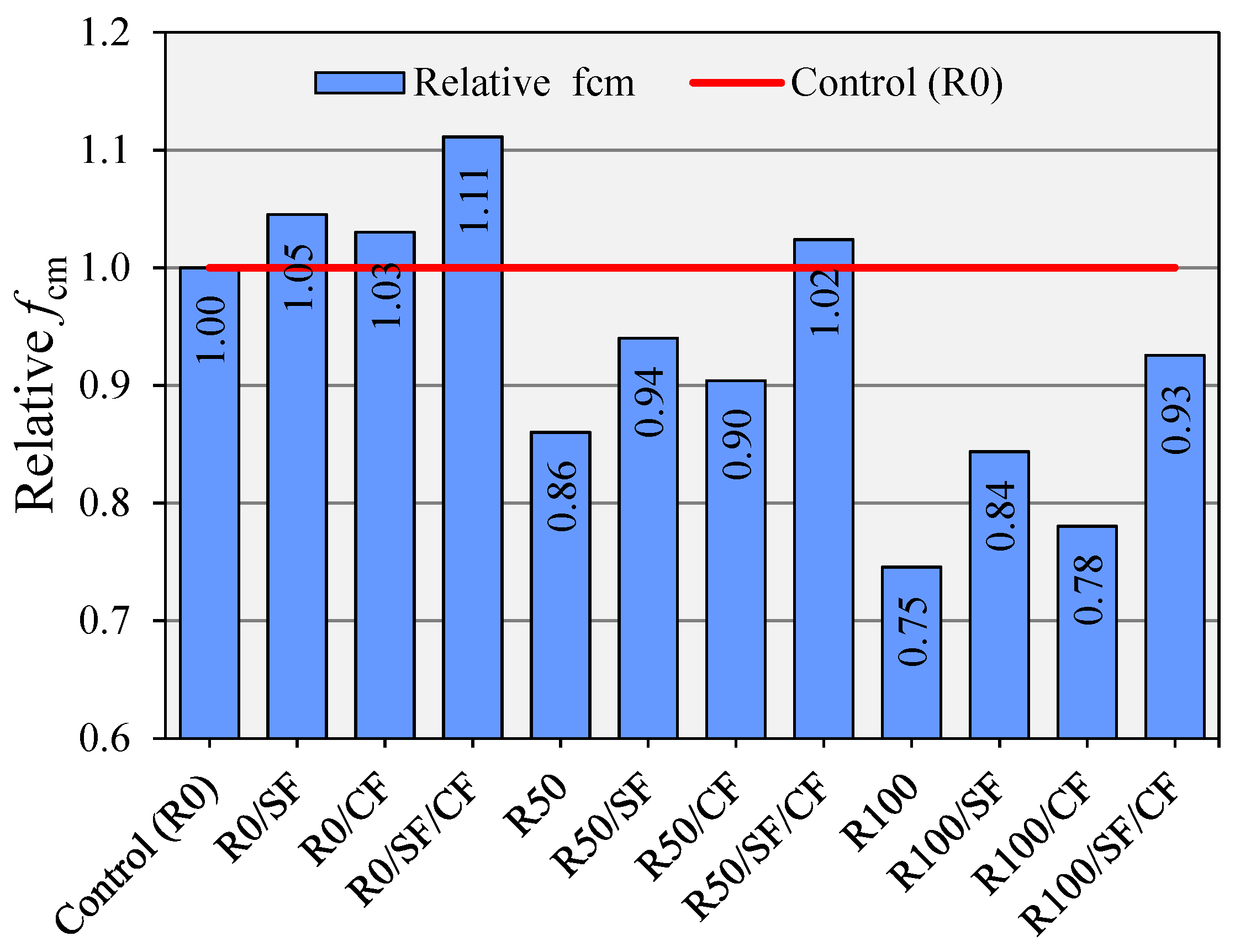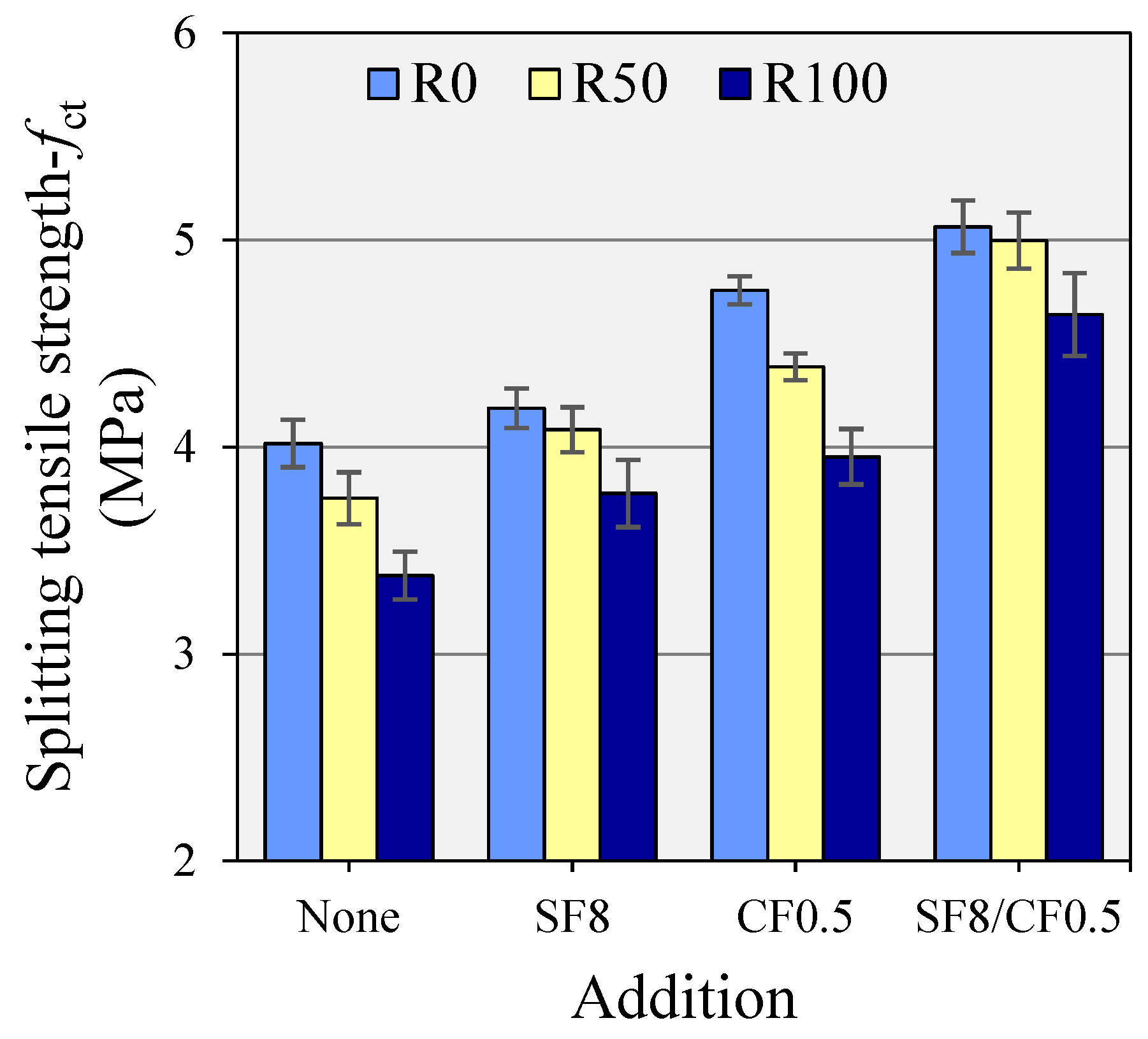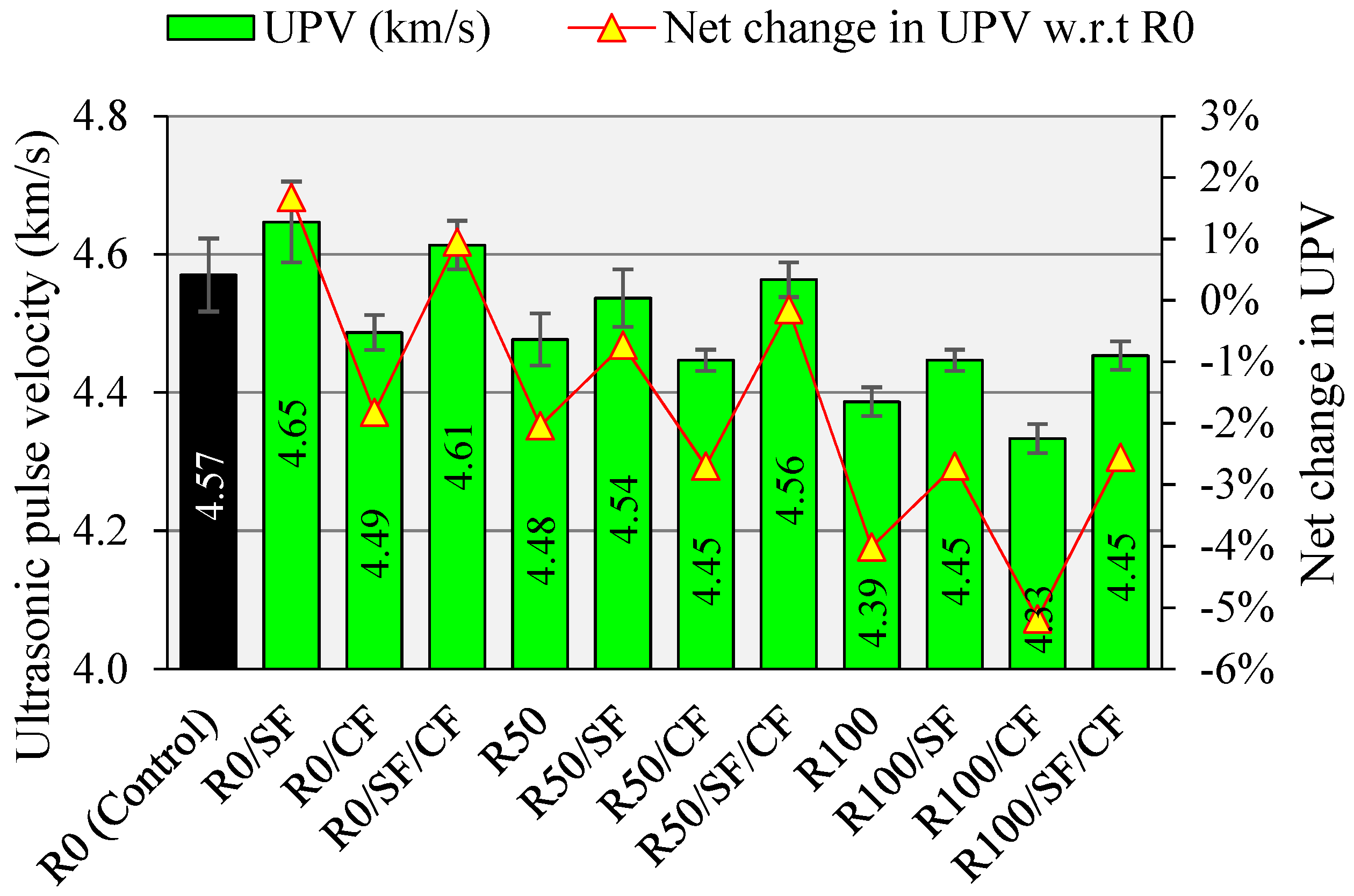Enhancing the Performance of Recycled Aggregate Concrete Using Micro-Carbon Fiber and Secondary Binding Material
Abstract
:1. Introduction
2. Materials and Methods
2.1. Characteristics of Constituent Materials
2.1.1. Portland Cement and Silica Fume
2.1.2. Natural and Recycled Aggregate
2.1.3. Carbon Fiber
2.1.4. Tap Water and Water Reducer
2.2. Characteristics of Constituent Materials
2.3. Testing Techniques
3. Results and Discussion
3.1. Compressive Strength
3.2. Splitting Tensile Strength
3.3. Bending Strength
3.4. Water Absorption
3.5. Ultrasonic Pulse Velocity
4. Conclusions
- The modification method using silica fume is highly effective in improving the compressive strength of recycled aggregate concrete. Concretes containing 50% and 100% recycled coarse aggregates experienced strength increments of around 9% at the addition of 8% silica fume. Carbon fiber caused nominal upgradation of 2–4% in compressive strength. At the combined use of 0.5% carbon fiber and 8% silica fume, the compressive strength of 100% recycled aggregate concrete was improved by 18%;
- The use of carbon fiber is effective in the upgradation of tensile strength. At the addition of 0.5% carbon fiber, concrete mixes made with 50% and 100% recycled aggregate experienced 16% and 14% improvements in splitting tensile strength, respectively. The combined use of silica fume and carbon fiber caused a maximum improvement of 32% in the splitting tensile strength of recycled aggregate concrete. The singular use of fiber or combined use of fiber and silica fume can overcome the tensile strength deficit of 100% recycled aggregate concrete;
- The singular addition of fiber is more useful than silica fume in upgrading the bending strength. Concretes with 50% and 100% recycled aggregates gained net improvements of 23% and 11%, respectively, due to the inclusion of 0.5% carbon fiber;
- The use of silica fume enhances the interfacial properties of aggregates and fibers; both fibers and silica cause a synergistic improvement in the tensile properties. The net effect of fiber on mechanical performance also improves with the addition of silica fume;
- Due to the addition of 0.5% carbon fiber and 8% silica fume, 100% recycled aggregate concrete achieved 19% greater bending strength than the control mix;
- Both recycled aggregate and fiber have a downward effect on the imperviousness of concrete. Thus, they can lead to a decline in the durability of concrete. The use of silica fume is highly effective in managing the negative effects of both fibers and inferior aggregates on the water absorption capacity and durability of concrete;
- The use of recycled aggregate noticeably reduces the pulse velocity; hence, the quality of concrete degrades. Fiber inclusion further has a minor but declining effect on the ultrasonic pulse velocity due to a possible increase in the porosity of concrete. Silica fume proved advantageous in refining the quality of concrete with and without recycled aggregate. Concrete made with 50% recycled coarse aggregate achieved excellent quality, with a pulse velocity value well above 4.5 km/s, owing to the filling and pozzolanic action of micro-silica.
Author Contributions
Funding
Institutional Review Board Statement
Informed Consent Statement
Data Availability Statement
Acknowledgments
Conflicts of Interest
References
- Revilla-Cuesta, V.; Skaf, M.; Faleschini, F.; Manso, J.M.; Ortega-López, V. Self-compacting concrete manufactured with recycled concrete aggregate: An overview. J. Clean. Prod. 2020, 262, 121362. [Google Scholar] [CrossRef]
- Junaid, M.F.; ur Rehman, Z.; Kuruc, M.; Medveď, I.; Bačinskas, D.; Čurpek, J.; Čekon, M.; Ijaz, N.; Ansari, W.S. Lightweight concrete from a perspective of sustainable reuse of waste byproducts. Constr. Build. Mater. 2022, 319, 126061. [Google Scholar] [CrossRef]
- Kurda, R.; Silvestre, J.D.; de Brito, J. Life cycle assessment of concrete made with high volume of recycled concrete aggregates and fly ash. Resour. Conserv. Recycl. 2018, 139, 407–417. [Google Scholar] [CrossRef]
- Ahmadi, M.; Farzin, S.; Hassani, A.; Motamedi, M. Mechanical properties of the concrete containing recycled fibers and aggregates. Constr. Build. Mater. 2017, 144, 392–398. [Google Scholar] [CrossRef]
- Kaplan, G.; Gulcan, A.; Cagdas, B.; Bayraktar, O.Y. The impact of recycled coarse aggregates obtained from waste concretes on lightweight pervious concrete properties. Environ. Sci. Pollut. Res. 2021, 28, 17369–17394. [Google Scholar] [CrossRef]
- Afroughsabet, V.; Biolzi, L.; Ozbakkaloglu, T. Influence of double hooked-end steel fibers and slag on mechanical and durability properties of high performance recycled aggregate concrete. Compos. Struct. 2017, 181, 273–284. [Google Scholar] [CrossRef]
- Dilbas, H.; Şimşek, M.; Çakır, Ö. An investigation on mechanical and physical properties of recycled aggregate concrete (RAC) with and without silica fume. Constr. Build. Mater. 2014, 61, 50–59. [Google Scholar] [CrossRef]
- Barbudo, A.; de Brito, J.; Evangelista, L.; Bravo, M.; Agrela, F. Influence of water-reducing admixtures on the mechanical performance of recycled concrete. J. Clean. Prod. 2013, 59, 93–98. [Google Scholar] [CrossRef]
- Ali, B.; Ahmed, H.; Ali Qureshi, L.; Kurda, R.; Hafez, H.; Mohammed, H.; Raza, A. Enhancing the Hardened Properties of Recycled Concrete (RC) through Synergistic Incorporation of Fiber Reinforcement and Silica Fume. Materials 2020, 13, 4112. [Google Scholar] [CrossRef]
- Kurda, R.; Silvestre, J.D.; de Brito, J.; Ahmed, H. Optimizing recycled concrete containing high volume of fly ash in terms of the embodied energy and chloride ion resistance. J. Clean. Prod. 2018, 194, 735–750. [Google Scholar] [CrossRef]
- Kurda, R.; de Brito, J.; Silvestre, J.D. Water absorption and electrical resistivity of concrete with recycled concrete aggregates and fly ash. Cem. Concr. Compos. 2019, 95, 169–182. [Google Scholar] [CrossRef]
- Kou, S.; Poon, C.; Agrela, F. Comparisons of natural and recycled aggregate concretes prepared with the addition of different mineral admixtures. Cem. Concr. Compos. 2011, 33, 788–795. [Google Scholar] [CrossRef]
- Qureshi, L.A.; Ali, B.; Ali, A. Combined effects of supplementary cementitious materials (silica fume, GGBS, fly ash and rice husk ash) and steel fiber on the hardened properties of recycled aggregate concrete. Constr. Build. Mater. 2020, 263, 120636. [Google Scholar] [CrossRef]
- Sasanipour, H.; Aslani, F.; Taherinezhad, J. Chloride ion permeability improvement of recycled aggregate concrete using pretreated recycled aggregates by silica fume slurry. Constr. Build. Mater. 2021, 270, 121498. [Google Scholar] [CrossRef]
- Alyousef, R.; Ali, B.; Mohammed, A.; Kurda, R.; Alabduljabbar, H.; Riaz, S. Evaluation of Mechanical and Permeability Characteristics of Microfiber-Reinforced Recycled Aggregate Concrete with Different Potential Waste Mineral Admixtures. Materials 2021, 14, 5933. [Google Scholar] [CrossRef] [PubMed]
- Mangi, S.A.; Raza, M.S.; Khahro, S.H.; Qureshi, A.S.; Kumar, R. Recycling of ceramic tiles waste and marble waste in sustainable production of concrete: A review. Environ. Sci. Pollut. Res. 2022, 29, 18311–18332. [Google Scholar] [CrossRef]
- Ali, B.; Qureshi, L.A. Influence of glass fibers on mechanical and durability performance of concrete with recycled aggregates. Constr. Build. Mater. 2019, 228, 116783. [Google Scholar] [CrossRef]
- Guler, S.; Öker, B.; Akbulut, Z.F. Workability, strength and toughness properties of different types of fiber-reinforced wet-mix shotcrete. In Structures; Elsevier: Amsterdam, The Netherlands, 2021; Volume 31, pp. 781–791. [Google Scholar]
- Köksal, F.; Altun, F.; Yiǧit, I.; Şahin, Y. Combined effect of silica fume and steel fiber on the mechanical properties of high strength concretes. Constr. Build. Mater. 2008, 22, 1874–1880. [Google Scholar] [CrossRef]
- Guler, S.; Akbulut, Z.F.; Siad, H.; Lachemi, M. Effect of macro polypropylene, polyamide and steel fibers on the residual properties of SCC at ambient and elevated temperatures. Constr. Build. Mater. 2021, 289, 123154. [Google Scholar] [CrossRef]
- Guler, S.; Akbulut, Z.F. Effect of high-temperature on the behavior of single and hybrid glass and basalt fiber added geopolymer cement mortars. J. Build. Eng. 2022, 57, 104809. [Google Scholar] [CrossRef]
- Ur Rehman, Z.; Khalid, U. Optimization of COVID-19 face mask waste fibers and silica fume as a balanced mechanical ameliorator of fat clay using response surface methodology. Environ. Sci. Pollut. Res. 2022, 29, 17001–17016. [Google Scholar] [CrossRef] [PubMed]
- Raza, S.S.; Amir, M.T.; Azab, M.; Ali, B.; Abdallah, M.; El Ouni, M.H.; Elhag, A.B. Effect of micro-silica on the physical, tensile, and load-deflection characteristics of micro fiber-reinforced high-performance concrete (HPC). Case Stud. Constr. Mater. 2022, 17, e01380. [Google Scholar] [CrossRef]
- Raza, S.S.; Qureshi, L.A. Effect of carbon fiber on mechanical properties of reactive powder concrete exposed to elevated temperatures. J. Build. Eng. 2021, 42, 102503. [Google Scholar] [CrossRef]
- Mastali, M.; Dalvand, A. Use of silica fume and recycled steel fibers in self-compacting concrete (SCC). Constr. Build. Mater. 2016, 125, 196–209. [Google Scholar] [CrossRef]
- Xie, J.; Fang, C.; Lu, Z.; Li, Z.; Li, L. Effects of the addition of silica fume and rubber particles on the compressive behaviour of recycled aggregate concrete with steel fibres. J. Clean. Prod. 2018, 197, 656–667. [Google Scholar] [CrossRef]
- Nazarimofrad, E.; Shaikh, F.U.A.; Nili, M. Effects of steel fibre and silica fume on impact behaviour of recycled aggregate concrete. J. Sustain. Cem. Mater. 2017, 6, 54–68. [Google Scholar] [CrossRef]
- ASTM-C150; Standard Specification for Portland Cement. ASTM International: West Conshohocken, PA, USA, 2018.
- Wang, Y.; Xu, Z.; Wang, J.; Zhou, Z.; Du, P.; Cheng, X. Synergistic effect of nano-silica and silica fume on hydration properties of cement-based materials. J. Therm. Anal. Calorim. 2020, 140, 2225–2235. [Google Scholar] [CrossRef]
- ASTM-C494; Standard Specification for Chemical Admixtures for Concrete. AASHTO: Washington, DC, USA, 2015.
- Yunchao, T.; Zheng, C.; Wanhui, F.; Yumei, N.; Cong, L.; Jieming, C. Combined effects of nano-silica and silica fume on the mechanical behavior of recycled aggregate concrete. Nanotechnol. Rev. 2021, 10, 819–838. [Google Scholar] [CrossRef]
- Xie, J.; Zhang, Z.; Lu, Z.; Sun, M. Coupling effects of silica fume and steel-fiber on the compressive behaviour of recycled aggregate concrete after exposure to elevated temperature. Constr. Build. Mater. 2018, 184, 752–764. [Google Scholar] [CrossRef]
- Ali, B.; Kurda, R.; Herki, B.; Alyousef, R.; Mustafa, R.; Mohammed, A.; Raza, A.; Ahmed, H.; Fayyaz Ul-Haq, M. Effect of Varying Steel Fiber Content on Strength and Permeability Characteristics of High Strength Concrete with Micro Silica. Materials 2020, 13, 5739. [Google Scholar] [CrossRef]
- Farooq, M.A.; Fahad, M.; Ali, B.; ullah, S.; El Ouni, M.H.; Elhag, A.B. Influence of nylon fibers recycled from the scrap brushes on the properties of concrete: Valorization of plastic waste in concrete. Case Stud. Constr. Mater. 2022, 16, e01089. [Google Scholar] [CrossRef]
- EN-12390-3; Testing of Hardened Concrete, Part 3: Compressive Strength of Test Specimens. British Standards Institution: London, UK, 2002.
- ASTM-C496; Standard Test Method for Splitting Tensile Strength of Cylindrical Concrete Specimens. ASTM International: West Conshohocken, PA, USA, 2017.
- ASTM-C1609; Standard Test Method for Flexural Performance of Fiber-Reinforced Concrete (Using Beam With Third-Point Loading). ASTM International: West Conshohocken, PA, USA, 2019.
- ASTM-C948 Standard; Test Method for Dry and Wet Bulk Density, Water Absorption, and Apparent Porosity of Thin Sections of Glass-Fiber Reinforced Concrete. ASTM International: West Conshohocken, PA, USA, 2016.
- Kurda, R.; de Brito, J.; Silvestre, J.D. Combined influence of recycled concrete aggregates and high contents of fly ash on concrete properties. Constr. Build. Mater. 2017, 157, 554–572. [Google Scholar] [CrossRef]
- Kazmi, S.M.S.; Munir, M.J.; Wu, Y.-F.; Patnaikuni, I.; Zhou, Y.; Xing, F. Axial stress-strain behavior of macro-synthetic fiber reinforced recycled aggregate concrete. Cem. Concr. Compos. 2019, 97, 341–356. [Google Scholar] [CrossRef]
- Khan, M.; Cao, M.; Ali, M. Effect of basalt fibers on mechanical properties of calcium carbonate whisker-steel fiber reinforced concrete. Constr. Build. Mater. 2018, 192, 742–753. [Google Scholar] [CrossRef]
- Khan, U.A.; Jahanzaib, H.M.; Khan, M.; Ali, M. Improving the tensile energy absorption of high strength natural fiber reinforced concrete with fly-ash for bridge girders. In Key Engineering Materials; Trans Tech Publications Ltd.: Wollerau, Switzerland, 2018; Volume 765, pp. 335–342. [Google Scholar]
- Kurda, R.; de Brito, J.; Silvestre, J.D. Indirect evaluation of the compressive strength of recycled aggregate concrete with high fly ash ratios. Mag. Concr. Res 2018, 70, 204–216. [Google Scholar] [CrossRef]
- Zheng, Y.; Zhuo, J.; Zhang, P.; Ma, M. Mechanical properties and meso-microscopic mechanism of basalt fiber-reinforced recycled aggregate concrete. J. Clean. Prod. 2022, 370, 133555. [Google Scholar] [CrossRef]
- BIS 13311-1; Method of Non-Destructive Testing of Concret, Part 1. Bureau of Indian Standards: Delhi, India, 1992.
- Das, C.S.; Dey, T.; Dandapat, R.; Mukharjee, B.B.; Kumar, J. Performance evaluation of polypropylene fibre reinforced recycled aggregate concrete. Constr. Build. Mater. 2018, 189, 649–659. [Google Scholar] [CrossRef]
















| Characteristic | Aggregate | ||
|---|---|---|---|
| Class | Fine | NCA | RCA |
| Material | Siliceous | Dolomitic sandstone | Laboratory concrete waste |
| Quarry | Lawrancepur | Kirana Hills | - |
| Max. size (mm) | 4.75 | 12.5 | 12.5 |
| Min. size (mm) | 0.075 | 2.36 | 2.36 |
| Relative density | 2.66 | 2.68 | 2.46 |
| Water absorption (%) | 1.09 | 1.17 | 3.35 |
| Batch ID | OPC (kg/m3) | SF (kg/m3) | Fine Aggregate (kg/m3) | Coarse Aggregate (kg/m3) | Water (kg/m3) | WR (kg/m3) | CF (kg/m3) | |
|---|---|---|---|---|---|---|---|---|
| NCA | RCA | |||||||
| R0 | 550 | 0 | 650 | 1075 | 0 | 181.5 | 2.15 | 0.00 |
| R0/SF | 506 | 31 | 650 | 1075 | 0 | 181.5 | 2.25 | 0.00 |
| R0/CF | 550 | 0 | 644 | 1069 | 0 | 181.5 | 3.65 | 9.25 |
| R0/SF/CF | 506 | 31 | 644 | 1069 | 0 | 181.5 | 3.98 | 9.25 |
| R50 | 550 | 0 | 650 | 538 | 489 | 181.5 | 2.21 | 0.00 |
| R50/SF | 506 | 31 | 650 | 538 | 489 | 181.5 | 2.46 | 0.00 |
| R50/CF | 550 | 0 | 644 | 534 | 486 | 181.5 | 3.94 | 9.25 |
| R50/SF/CF | 506 | 31 | 644 | 534 | 486 | 181.5 | 4.15 | 9.25 |
| R100 | 550 | 0 | 650 | 0 | 978 | 181.5 | 2.31 | 0.00 |
| R100/SF | 506 | 31 | 650 | 0 | 978 | 181.5 | 2.58 | 0.00 |
| R100/CF | 550 | 0 | 644 | 0 | 972 | 181.5 | 3.84 | 9.25 |
| R100/SF/CF | 506 | 31 | 644 | 0 | 972 | 181.5 | 4.35 | 9.25 |
| UPV (km/s) | Concrete Grading (Quality) |
|---|---|
| Above 4.5 | Excellent |
| 3.5 to 4.5 | Good |
| 3.0 to 3.5 | Medium |
| Below 3.0 | Doubtful or inferior |
Publisher’s Note: MDPI stays neutral with regard to jurisdictional claims in published maps and institutional affiliations. |
© 2022 by the authors. Licensee MDPI, Basel, Switzerland. This article is an open access article distributed under the terms and conditions of the Creative Commons Attribution (CC BY) license (https://creativecommons.org/licenses/by/4.0/).
Share and Cite
Raza, S.S.; Fahad, M.; Ali, B.; Amir, M.T.; Alashker, Y.; Elhag, A.B. Enhancing the Performance of Recycled Aggregate Concrete Using Micro-Carbon Fiber and Secondary Binding Material. Sustainability 2022, 14, 14613. https://doi.org/10.3390/su142114613
Raza SS, Fahad M, Ali B, Amir MT, Alashker Y, Elhag AB. Enhancing the Performance of Recycled Aggregate Concrete Using Micro-Carbon Fiber and Secondary Binding Material. Sustainability. 2022; 14(21):14613. https://doi.org/10.3390/su142114613
Chicago/Turabian StyleRaza, Syed Safdar, Muhammad Fahad, Babar Ali, Muhammad Talha Amir, Yasser Alashker, and Ahmed Babekar Elhag. 2022. "Enhancing the Performance of Recycled Aggregate Concrete Using Micro-Carbon Fiber and Secondary Binding Material" Sustainability 14, no. 21: 14613. https://doi.org/10.3390/su142114613
APA StyleRaza, S. S., Fahad, M., Ali, B., Amir, M. T., Alashker, Y., & Elhag, A. B. (2022). Enhancing the Performance of Recycled Aggregate Concrete Using Micro-Carbon Fiber and Secondary Binding Material. Sustainability, 14(21), 14613. https://doi.org/10.3390/su142114613






